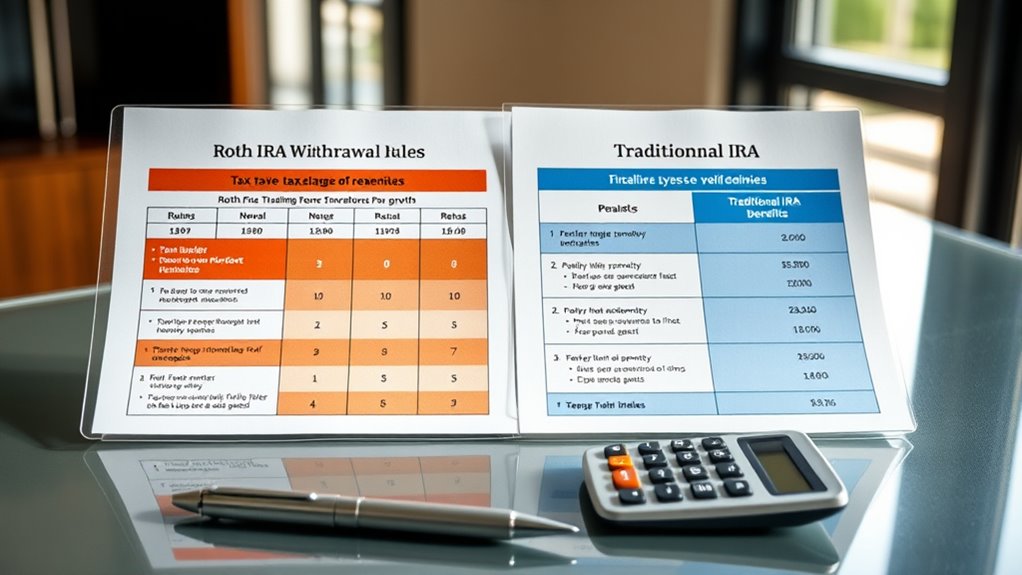Choosing between Roth and Traditional IRAs depends on your current income, tax situation, and future plans. Roth IRAs let you contribute with after-tax dollars and enjoy tax-free withdrawals later, ideal if you expect higher future taxes. Traditional IRAs offer immediate tax deductions but require taxes on withdrawals. Your decision impacts your retirement savings and taxes, so exploring these options further will help you make the best choice for your future.
Key Takeaways
- Traditional IRAs offer immediate tax deductions, reducing current taxable income, while Roth IRAs provide tax-free withdrawals in retirement.
- Roth IRAs are funded with after-tax dollars, making qualified withdrawals tax-free; Traditional IRAs offer tax-deferred growth but taxed upon withdrawal.
- Income limits restrict Roth IRA contributions; Traditional IRAs have no income limits but may have limited tax benefits at higher incomes.
- Early withdrawals from Traditional IRAs typically incur penalties, whereas Roth IRA contributions can be withdrawn anytime without penalties.
- The choice depends on current vs. future tax preferences, retirement income expectations, and eligibility based on income and age.
Key Features and Eligibility Criteria

Understanding the key features and eligibility criteria of Roth and Traditional IRAs helps you determine which account best suits your retirement goals. Traditional IRAs often allow you to make contributions with potential tax deductions, known as Traditional deductions, which can lower your current taxable income. However, these contributions may be taxed upon withdrawal. Roth IRAs, on the other hand, are funded with after-tax dollars, meaning you don’t get an immediate deduction, but qualified withdrawals are tax-free. If your income exceeds certain limits, a Roth conversion might be an option to move funds from a Traditional IRA into a Roth account, enabling future tax-free growth. Your eligibility for each depends on income and filing status, so understanding these criteria helps you plan efficiently.
Tax Advantages and Implications

Tax advantages are a primary reason many choose between Roth and Traditional IRAs. Roth benefits include tax-free withdrawals in retirement, while Traditional deductions reduce your taxable income now. With a Roth, you pay taxes upfront, so your savings grow tax-free. Conversely, Traditional IRAs let you lower your current taxable income, providing immediate savings. Imagine a clear pathway:
- You contribute after-tax dollars, enjoying future tax-free growth, like a blooming tree.
- You deduct contributions now, like a shield reducing your current tax bill.
- Roth withdrawals are tax-free, like a harvest without taxes.
- Traditional deductions lower your taxable income today, like a curtain hiding your earnings.
- Future taxes on Traditional IRAs can be higher, like a looming shadow. Your choice hinges on whether you prefer tax breaks now or later.
Contribution Limits and Income Restrictions

Contribution limits and income restrictions play a essential role in deciding which IRA type is right for you. For 2024, the annual contribution limit is $6,500 ($7,500 if you’re age 50 or older). Roth IRAs have income restrictions; for example, single filers must earn less than $153,000 to contribute directly. Traditional IRAs have no income limits but may not offer full tax benefits if your income exceeds certain thresholds. Age restrictions also matter, especially for Traditional IRAs, which typically require minimum distributions starting at age 73. Spousal benefits allow you to contribute to a spousal IRA if your partner has little or no income. Here’s a quick comparison:
| IRA Type | Income Restrictions | Age Restrictions | Spousal Benefits |
|---|---|---|---|
| Roth IRA | Yes, income limits apply | No age limit for contributions | Yes, if spouse has income |
| Traditional IRA | No income limits, tax deductibility varies | Yes, contributions allowed until age 73 | Yes, with earned income |
Withdrawal Rules and Penalties

Withdrawal rules and penalties are crucial to consider because they directly impact how and when you can access your retirement funds without incurring costly charges. For Roth IRAs, a Roth withdrawal allows you to take out your contributions at any time without penalties, but earnings may be taxed or penalized if not qualified. Traditional IRAs require you to wait until age 59½ to avoid penalties, with early withdrawals typically incurring a 10% penalty. Penalty exceptions can apply, such as for first-time home purchases or qualified education expenses. Visualize these scenarios:
Understanding IRA withdrawal rules helps avoid costly penalties and optimizes access to your retirement funds.
- Taking contributions freely from your Roth IRA anytime
- Facing penalties for early withdrawals of earnings
- Qualifying for penalty exceptions during hardship
- Accessing funds before retirement age
- Navigating tax implications with each withdrawal
Understanding these rules helps you plan withdrawals carefully to avoid unexpected costs.
Suitability for Different Retirement Strategies

Your choice between Roth and Traditional IRAs depends heavily on your tax situation and when you prefer to pay taxes. If you expect to be in a higher tax bracket later, a Roth might suit your strategy better, especially with early contributions. Conversely, if you want immediate tax benefits and plan to contribute more later, a Traditional IRA could be more appropriate.
Tax Impact Differences
Understanding the tax impacts of Roth and Traditional IRAs is essential because they influence how your retirement savings grow and how much you’ll owe when you withdraw. With a Traditional IRA, you benefit from a tax deduction now, reducing your current taxable income, which aids in tax planning. However, you’ll pay taxes on withdrawals in retirement. Conversely, Roth IRAs require no immediate deduction, but qualified withdrawals are tax-free, offering long-term tax advantages. Imagine:
- Saving more now due to a tax deduction
- Growing your investments tax-deferred
- Enjoying tax-free income later
- Planning for unpredictable future tax rates
- Balancing current versus future tax liabilities
Your choice impacts your strategy: do you prefer immediate tax relief or tax-free income in retirement? This decision shapes your overall retirement plan.
Early vs. Late Contributions
Choosing between making early or late contributions to your IRA depends on your retirement timeline and financial goals. Early contributions allow you to maximize tax advantages and growth potential over time, which is ideal if you plan to retire later and want to take advantage of compounding interest. Late contributions, on the other hand, suit those who start saving later or want to catch up on retirement savings, especially if they’re closer to retirement age. Early contributions provide more time for investments to grow, while late contributions help fill gaps if you’ve delayed saving. Your strategy should align with your income, age, and retirement plans, balancing the benefits of early contributions’ growth with the flexibility of late contributions when needed.
Making the Right Choice for Your Future

Deciding between a Roth IRA and a Traditional IRA can considerably impact your financial future. To make the right choice, consider your current and future tax situation, retirement goals, and estate planning needs. Picture your future self enjoying a tax-free withdrawal from a Roth, or perhaps benefiting from immediate tax deductions with a Traditional IRA. Your decision influences your investment strategies and how your estate is passed on. Think about these factors:
- Your current income and tax bracket
- Expected future income
- Flexibility in withdrawals
- Legacy goals for heirs
- The timing of tax advantages
Frequently Asked Questions
Can I Convert a Traditional IRA to a Roth IRA Later?
Yes, you can convert a traditional IRA to a Roth IRA later. You just need to explore your conversion options and understand the tax implications. When you make the conversion, you’ll owe taxes on the amount converted, since traditional IRAs are funded with pre-tax dollars. It’s important to plan ahead, as the timing and amount of your conversion can impact your tax bill and overall retirement strategy.
How Do Roth and Traditional IRAS Impact Estate Planning?
Roth and traditional IRAs influence your estate transfer and legacy planning differently. With a Roth IRA, your heirs can enjoy tax-free withdrawals, helping you build a lasting legacy. Traditional IRAs, however, may require heirs to pay income taxes on withdrawals, potentially reducing your estate’s value. By choosing wisely, you can optimize estate transfer and legacy planning, ensuring your assets support your loved ones according to your wishes.
Are There Differences in Required Minimum Distributions (RMDS)?
Yes, there are differences in RMDs between Roth and traditional IRAs. Traditional IRAs require you to start taking RMDs at age 73, impacting your tax implications since these distributions are taxable. Roth IRAs, however, have no RMD requirements during your lifetime, allowing your contributions to grow tax-free. Keep in mind, contribution limits apply to both types, but RMD rules influence your retirement planning and tax strategy.
Which IRA Type Offers More Flexibility in Investment Choices?
Imagine your retirement portfolio as a garden—your choice of IRA determines the variety of plants you can cultivate. Roth IRAs generally offer more investment options and greater account flexibility, letting you choose from a broader array of investments like stocks, bonds, and funds. This flexibility empowers you to tailor your investment strategy, giving you more control over your retirement growth. So, if variety matters, a Roth might be your best pick.
How Do State Taxes Affect Roth Versus Traditional IRA Withdrawals?
State tax implications substantially impact your Roth and traditional IRA withdrawals. With Roth IRAs, qualified withdrawals are usually tax-free, but some states still tax the earnings if you don’t meet criteria. Traditional IRAs often require you to pay state income tax on withdrawals, which can increase your tax burden. Be aware of withdrawal penalties if you access funds early, especially if your state enforces stricter rules. Planning ahead helps minimize surprises and maximize your retirement savings.
Conclusion
Choosing between a Roth and traditional IRA is like picking the right tool for a job—you need what best fits your goals. Imagine planting a seed today (traditional IRA) versus watering it later (Roth); both grow your future, but each requires a different approach. By understanding their differences, you can nurture your retirement savings wisely. Remember, the right choice today sets the foundation for a secure tomorrow—so choose the one that aligns with your vision.










